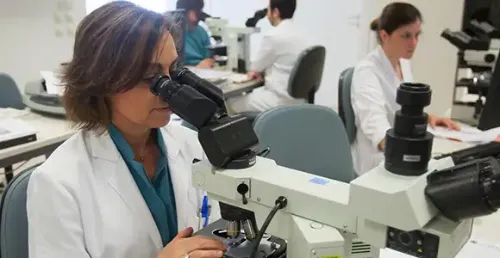Blistering diseases
"Interdisciplinary coordination in the diagnosis and treatment of patients with autoimmune blistering diseases is of vital importance. Therefore, patients will be evaluated by the departments of Dermatology, Otorhinolaryngology and Ophthalmology".
DR. AGUSTÍN ESPAÑA
DIRECTOR. DERMATOLOGY DEPARTMENT

In autoimmune blistering diseases, patients produce autoantibodies directed against skin proteins and therefore favoring a loss of adhesion of the dermal structure.
The autoimmune diseases, as a whole, are characterized by imbalances in the immune system, which produces a damage of the own tissues by the leukocytes (white blood cells) of the own patient, or by the production of immunoglobulins (autoantibodies).
In blistering diseases, although there is a genetic predisposition in these patients to present these diseases, it can be induced by several factors, such as virus infections or the administration of certain drugs.

What are the symptoms of blistering diseases?
Depending on whether the loss of adhesion occurs between the keratinocytes, and therefore within the epidermis, or if it occurs due to alteration of the basal membrane, between the epidermis and the dermis, we will have some intraepidermal or other subepidermal forms.
Within the intra-epidermal blistering diseases, a group of diseases stands out, which as a whole are called pemphigus, and can be subdivided into several types:
- Superficial pemphigus: Pemphigus foliaceus and pemphigus erythematosus stand out.
- Deep pemphigus: highlights the pemphigus vulgaris, pemphigus familiar benign (Haley-Haley disease) and pemphigus vegetante.
- IgA pemphigus: subcorneal pustular dermatosis and IgA neutrophilic intraepidermal dermatosis.
- Paraneoplastic pemphigus: patients have an associated neoplasm.
The autoimmune blistering diseases that are characterized by the inflammation between the epidermis and dermis, by a damage in the basal membrane, can be divided into several types:
- Blistering pemphigoid and scar pemphigoid.
- Herpes gestationis.
- Dermatitis herpetiformis.
- Epidermolysis bullous acquired.
Los síntomas más habituales son:
- Alopecia (pérdida de pelo).
- Picor en la piel (prurito).
- Úlceras en piel y boca.
- Vesículas en la piel.
Do you have any of these symptoms?
You may have a blistering disease
How are blistering diseases diagnosed?

The diagnosis of each of them is based on:
- Physical examination of the patient: the patient is initially given an anamnesis and a complete physical examination, evaluating the lesions that he presents, both on the skin and on the mucous membranes.
- Histological diagnosis: On the same day that the patient is clinically evaluated, a biopsy is performed on one of the skin or mucosal lesions. This same sample allows the direct immunofluorescence study to be carried out.
- Molecular biology studies that allow a more precise diagnosis of each of these diseases.
Immunological diagnosis:
- Diagnosis through indirect immunofluorescence and ELISA: A blood sample obtained from the patient at the time of the consultation, allows the quantification of the circulating autoantibody titer. The comparison of this result with the one obtained in later controls, allows to analyze the evolution and activity of the disease in each case.
- Diagnosis by immunoblotting: By means of this technique we can definitively confirm that each patient presents a specific disease, since we can establish that he or she is producing autoantibodies directed against the protein (antigen) involved in that process.
The Department of Dermatology of the Clínica Universidad de Navarra has a collaboration agreement with the Department of Dermatology of the University of North Carolina for the production of immunoblots in patients with pemphigus vulgaris and pemphigus foliaceus.
Only one blood sample is needed from each patient.
Likewise, this agreement exists also with the Department of Dermatology of the University of Wuerzburg in Germany, for the realization of immunoblots in patients who present a subepidermal autoimmune blistering disease, such as blistering pemphigoid, cicatricial pemphigoid or herpes gestationis.
How are blistering diseases treated?
- Corticoids: Its pharmacology is known to have anti-inflammatory and immunosuppressive effects.
- Immunosuppressants: Azathioprine, Mycophenolate,
Cyclophosphamide, Methotrexate
Intravenous immunoglobulins. - Rituximab. It is one of the drugs called biological: they attack the specific parts of the immune system that cause inflammation and tissue damage.
- Sulfone. Its mechanism of action is little known, but it is believed that it is an anti-inflammatory effect.
- Tetracyclines and nicotinamide. Certain antibiotics, including tetracycline derivatives and erythromycin, have an anti-inflammatory action in addition to bacteriostatic. This fact has allowed their use in processes that have an immunological mechanism in their triggering. In addition, given the absence of significant side effects has allowed its use in older people.Tetracyclines are usually associated with nicotinamide due to their action on different key points of the inflammatory response.
Where do we treat them?
IN NAVARRE AND MADRID
The Department of Dermatology
of the Clínica Universidad de Navarra
The Department of Dermatology of the Clinica Universidad de Navarra has extensive experience in the diagnosis and treatment of dermatological diseases.
We have extensive experience in highly precise surgical treatments, such as Mohs surgery. This procedure requires highly specialized personnel.
We have the latest technology for the dermo-aesthetic treatment of skin lesions, with the aim of achieving the best results for our patients.
Diseases we treat

Why at the Clinica?
- Experts in Mohs Surgery for the treatment of skin cancer.
- We have the best technology for dermo-aesthetic treatments.
- Safety and quality assurance of the best private hospital in Spain.








